|
< Earlier Kibitzing · PAGE 2 OF 2 ·
Later Kibitzing> |
| May-12-09 | | CHESSTTCAMPS: Material is even, but black's pieces have all the active spots and white's pieces are relegated to passive defense. Apparently white has placed the king on f1 to avoid the pressure on the g and h-files and in anticipation of the advance of black's h-pawn. However, this has left an entry point on h1 that black exploits with: 74... Rxf4!
... and white can resign immediately. Curiously, I brought up this position last night after a long day and I couldn't see anything, preoccupied with the attack on g3. This morning, I found the solution instantly. |
|
| May-12-09 | | euripides: Nimzowitsch looked at Chigorin's games. I think he must have enjoyed this one. |
|
May-12-09
 | | doubledrooks: I went with the decoy move 74...Rxf4 with a double attack and pin of the unprotected white queen. If 75. Qxf4 then ...Qh1#, as the white queen no longer protects h1. |
|
| May-12-09 | | Hortensius: Once you spot the mate on Qh1, it's easy to see... |
|
| May-12-09 | | SuperPatzer77: After 76...Ng3+ White resigns in lieu of 77. Ke1 Qxe2# or 77. Kg1 Qh1# (I actually meant 7...Nxe2+) so, I overlooked 77...Qh1# Thanks to <agb2002> for correcting my incorrect analysis when I meant 77. Kg1 Nxe2+. It should be 77...Qh1# - I actually didn't see. SuperPatzer77 |
|
| May-12-09 | | binno: This take me a lot of time too. And like <JG27Pyth> i've considered the key move early not understanding it. After ten minutes of analisis i had reconsidered it. <dzechiel> you are very popular on this site. I also respect you. |
|
| May-12-09 | | corbinamman: Judging from the comments, I solved this one more quickly than most...BUT...I missed the Monday puzzle this week completely. Goes to show that we all have our blind spots! |
|
| May-12-09 | | GreenFacedPatzer: Bother: missed a Tuesday.
I spent a lot of time staring at other promising, forcing combinations that look as if they might work, only to find white's defense hold again and again. (A fork based on Ng3+? Nope. Can I sacrifce to remove the defenders? Yes, but in the end I'm down to no material, and White wins with R vs. nothing. Fork based on Nd2+? Nope: the Rook's got it covered. Can I force the rook to move? Yes... but not in a way which leaves the fork useful.) In the end, I couldn't see anything better than Qh3+... and even that doesn't seem to win much, besides forcing a bit of retreat. Oh, well, on to Wednesday and the hope for better things. |
|
| May-12-09 | | David2009: What a lovely-looking position White had at move 40 - apart from a bad Bishop, the one cloud in the sky. |
|
| May-12-09 | | SamAtoms1980: 74 ... Rxf4 wins. I spotted this one in 6-8 minutes. |
|
| May-12-09 | | WhiteRook48: how about 75. Qxf4? |
|
| May-12-09 | | MaczynskiPratten: <WhiteRook48: how about 75. Qxf4?> Qh1#! |
|
| May-12-09 | | FrogC: Got this after a fairly long think. What's so attractive about Rxf4 is it combines three tactical themes: it's a pin of queen to king preventing Qxh5, a discovered attack on the queen in the event of gxf4 and a decoy of the queen in the event of Qxf4. Not bad for one move. |
|
| May-12-09 | | DarthStapler: Got it |
|
| May-12-09 | | Some call me Tim: The mind is a funny thing...this one took me about a minute and a half because I tried the pin and uncovering of the Q second after trying ...Qh3+ and finding nothing forcing after Kg1. Yet Rxf4 seems a longshot even to consider. Pin to win! |
|
| May-13-09 | | Kasputin: Didn't get to get to this until the next day.
I did see 74 ... Rxf4+ (see that it wins the queen or leads to mate) but it took awhile longer than usual. I kept getting distracted by the knight and possible forks so it was a little while before I even considered it. |
|
| May-13-09 | | kevin86: I missed this one: The real key is that 75 ♕xf4 is met by the quaint (and lethal) shot of 75...♖h1#. Now,black will gain white's queen. |
|
| Jun-01-09 | | patzer2: Black's 74...Rxf4! combines the pin and deflection tactics to win decisive material. |
|
| Nov-18-15 | | YvccChamp: Great finish by Steintz's antipode! These two great players trumpeted in the new ideas that would speed up chess development! |
|
Feb-22-20
 | | KEG: Tchigorin was one of only two undefeated players in the tournament going into this 7th round game (Alapin being the other). With Tchigorin's win here and with Alapin's defeat of Janowski in the same round, six players were now within a fraction of a point of the lead: Janowski, Tchigorin, Alapin, Gunsberg, von Scheve, and Schlechter. Because of replays and because of the unusual scoring system, it was difficult to determine the exact order on the leader board (e.g., Janbowski had 5 points but no replays, while Tchigorin had 4.75 points with two games to be replayed (worth 1/2 point each) and Alapin and Gunsberg had the same score but with only one replay outstanding. Whatever the complicated leader board, this was a tedious game featuring a blocker position that seemed to give neither side any chances to break through. Even after the position loosened up a bit with exchanges on moves 59 and 61, the game seemed to be a dull draw until Reggio's blunder on move 67, Tchigorin's failure to capitalize on move 68, Reggio's blunder on move 74, followed by Tchigorin's brilliant concluding combination. Perhaps best to examine the opening and then pick up the action around move 53 or so. 1. d4 d5
2. c4 Nc6
Tchigorin's patented defense to the Queen's Gambit. Whatever its theoretical drawbacks, this was a line well-known by Tchigorin that had brought him many important victories. Anyone facing Tchigorin in this line had to beward. 3. Nf3
3. cxd5 and 3. Nc3 are good alternatives. In any case, White has a theoretical edge, but facing this over the board against Tchigorin must have been a daunting experience. "3. Nc3, and if 3...dxc4 (in order to play e5), 4. d5, prevents Tchigorin's favorite attack, though indeed there seems to be no object in preventing it." (Pollock in the St. Peterburg 1895-1896 Tournament Book). 3... Bg4
Another Tchigorin favorite. With his preference of Knights over Bishops, the minor piece exchange now possible suited his style. For mere mortals, 3...e6 is a good alternative. 4. cxd5 BxN
All according to plan.
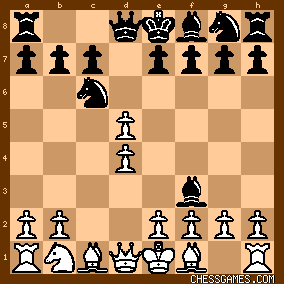
click for larger view5. dxN
"?"--(Monte Carlo 1901 Tournament Book)
"The same error that Pillsbury made [twice--KEG] at St. Petersburg 1895/6. White concedes a strong Bishop pair, compensation for Black's weak centre. 5...gxB was correct." [Monte Carlo 1901 Tournament Book] "We still hold the Bishop to be better worth capturing than the Knight, as indeed experience seems to have proved." [Pollocak in the 1895/1896 St. Petersburg Tournament Book]. Pillsbury played the text against Tchigorin in both rounds 4 and 11 at St. Petersburg 1895/1896, winning the first game and losing the second. He switched to a different line (i.e., 4. e3) in this 18th round game against Tchigorin at this tournament. While 5. gxB certainly looks better, White is still fine--and probably still has a (slight) edge, even after the text. 5... Bxc6
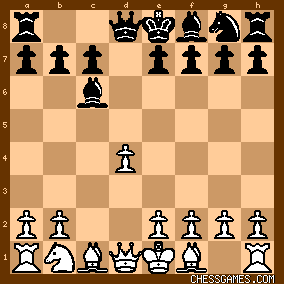
click for larger view6. Nc3 e6
7. e4
Stronger in my view than the prophylactic 7. a3. 7... Bb4
Tchigorin played--and lost--with 7...Nf6 against Pillsbury in the 4th round at St. Petersburg 1895/1896. The text was the improved line he used successfully in his second game as Black against Pillsbury at St. Petersburg 1895/1896. Reggio should have been prepared for this move. "Compare [7...Nf6] in the fourth round between the same opponents [Pillsbury and Tchigorin] . Black here improves his play in a most ingenious manner." [Pollock in the St. Petersburg 1895/1896 Tournament Book]. The position after 7...Bb4 was:
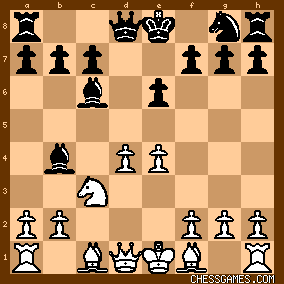
click for larger view |
|
Feb-23-20
 | | KEG: Post II
8. f3
"Against 7...Nf6 [as played by Pillsbury in the first of his two games in this line against Tchigorin at St. Petersburg 1895-1896] this was THE move. And, as a rule, this method of preserving the e-pawn is the best one in cases where there is no danger from the adverse King's Bishop commanding the diagonal (a7...g1) against the castled King. The question is, IS there any such danger? The answer is not far to seek." [Pollock in the 1895-1896 Tournament Book). 8... f5
"!"--(Monte Carlo Tournament Book)
"Exceedingly vigorous play and evidently well considered." (Pollock in the St. Petersburg 1895/1896 Tournament Book) 9. e5
"9. exf5, however followed up, is highly unsatisfactory, Black shortly Castling Queen-side and attacking the d-pawn. There remains but the heroic course 9. Bc4..." (Pollock, op. cit.) Without necessarily buying into all of Pollock's musings, 9. Bc4 does look clearly best for White here and should give him the better game, whereas the game is at best even for Reggio after the text. 9... Ne7
10. a3
"As the opening has clearly not gone the way intended by White [speaking of Pillsbury-Tchigorin], it would be safer policy to aim at an even game by developing 10. Bc4, followed if 10...Nd5 by BxN, 0-0, and if necessary Be3. Anyway, there seems no reason for making the adverse Bishop move away to a better square." (Pollock, op. cit.). 10... Ba5
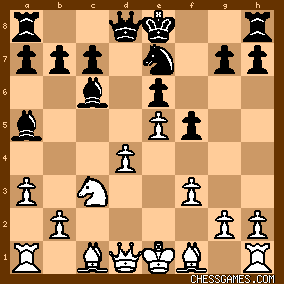
click for larger view11. b4
Pillsbury played the (better) 11. Bc4 against Tchigorin at St. Petersburg 1895/1896. Pollock in the tournament book there suggested the text as an alternative. Reggio, perhaps influenced by Pollock's analysis, tried the text and wound up with a difficult position with strong pressure against his d-pawn. 11... b6
12. Be3 0-0
Pollock in analyzing 11. b4 had recommended the superior 12...Nd5. Other options more assertive than the text were 12...a5 and 12...f4. 13. Bc4
Better late than never! 13. Bf2 was also a reasonable choice. 13... Bd5
13...Nd5 was still a stronger choice.
After 13...Bd5, the position was:

click for larger view14. Qb3
It is hard to understand why Reggio didn't seek equality with 14. NxB 14... c6
Tchigorin could have maintained his edge with 14...BxB. 15. Rd1
15. 0-0 or 15. Bf2 were better.
15... Ng6
Tchigorin's uncertain handling of the Black side here is surprising given that this was a game in his favored 2...Nc6 variation. Either 15...BxB or 15...a5 were the best ways for Black to play for an advantage. The position was now: 
click for larger view16. BxB exB
"Black would have improved his positional advantage by 16...cxB followed by doubled Rooks on the c-file..." (Tournament Book). 16...cxB would indeed have been better. Tchigorin was now to be saddled with the inferior position for a long time as a result of the text. 
click for larger view |
|
Feb-23-20
 | | KEG: Post III
17. f4 Qh4+
18. g3 Qh3
19. Kf2

click for larger view19... Rae8
Too committal. 19...Rab8 or 19...Rfe8 or 19...Rfe8 would give more flexibility. 20. Ne2
20. Na4 and 20. b5 were other good alternatives. 20... Rf7
Tchigorin might have considered backtracking with 20...Qh5 or untangling his Rooks with 20...Rb8 or c8. 21. Ng1
Given Tchigorin's indecisive play, Reggion might have ventured 21. a4. 21... Qh5
22. Nf3

click for larger view"White has now approximately equalized." (Tournament Book). If anything, White has the better game.
22... Nf8
23. h4
Play on the Queen's side with 23. a4 was better. 23... Rc7
Since a6 will eventually be necessary, Tchigorin should probably have played it here. 24. Rc1 Qf7
25. h5
"Looks gratuitous." (Milo on this site_.
While the text is not all that bad, 25. a4 still appears to be the beginning of a better plan. 25. Ng5 was an interesting alternative. 25... Ne6
26. Qd3 Rf8
27. Rc2 Qe8
28. Bc1

click for larger view28... Rcf7
Tchigorin should have anticipated White's Queen-side advance with 28...a5 or 28...a6. 29. a4!
Suddently, White has threats.
29... Qd7

click for larger view30. a5
This was the last move before the time control. This may explain Reggio's failure to find the very strong 30. Ba3. 30... Bd8
31. Bd2
Having said "A," Reggio might as well have played 31. a6. 31... a6
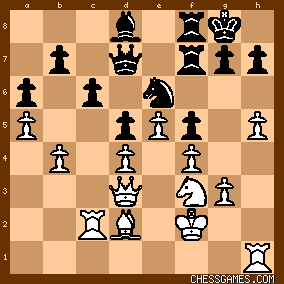
click for larger viewLockdown! The only question now appears to be when either Reggio or Tchigorin will play h6. Incredibly, neither side ever made that move, and the pawns on h5 and h7 remained in place until Tchigorin finally broke the ice with g6 on move 58. From here, the game was about to enter an extremely dull phase. The only balm I can offer the readers is that the conclusion of the game at least partially redeems the tedium of playing over the next 20-30 or so moves. |
|
Feb-23-20
 | | KEG: Post IV
Beginning here and through about move 52, both Fritz and Stockfish suggest White is better, and think White can exploit this edge by playing h6 and that Black can hang on by playing h6. However, neither software is able to find a convincing winning line after White's h6. In short, there is no clear way for either side to make progress. 32. Rcc1 Be7
33. Kg2 Kh8
34. Kf2 Rg8
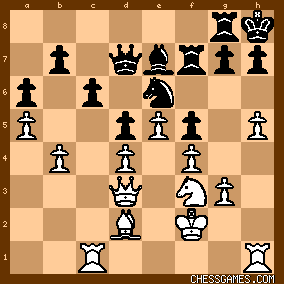
click for larger view35. Nh4
Allows Tchigorin to trade Bishop for Knight (a favorite with Tchigorin) but does little to alleviate the blocked nature of the position. 35... BxN
36. RxB
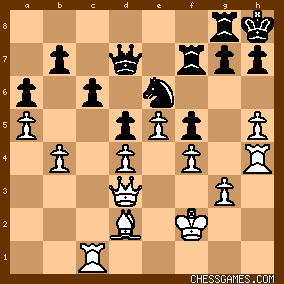
click for larger view36... Rgf8
37. Rg1 Qd8
38. Kg2 Nc7

click for larger view"I love the way Chigorin maneuvers his Knight to gain control of the light squares." (Rowson on this site). 39. Kh1 Qe7
40. Be1 Ne6
41. Rh2 Kg8
42. Bd2 Qd8
43. Rc1 Qd7
44. Rg1 Kh8
45. Be3 Nc7

click for larger viewThe second time control had been reached. Tchigorin now tried a different tactic with his Knight, but it--like everything else for many moves--got nowhere. 46. Qd2 Nb5
47. Qe1 Qe6
48. Qc1 Na7
49. Qe1 Nc8
50. Bc1 Ne7
51. Be3 Re8
52. Bc1 Ng8

click for larger view53. Rh4
This misplacement of the Rook gave Tchigorin a small opening. 53... Nf6
Cute.
54. Bd2 Ne4!
55. Qe2 Rg8
56. Be1 Nf6
But this gets Black nowhere. Perhaps the neat 56...Rf6 (obviously the Rook cannot be taken) was a better way to make progress. 57. Rg2 Ng4
58. Qd3
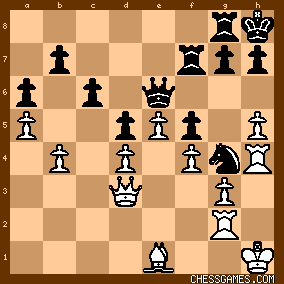
click for larger viewIt was here that Tchigorin managed to inject some life into this tedious game, and what followed was (finally) of interest. |
|
Feb-23-20
 | | KEG: Post V
The endless and often pointless shuffling of pieces suggested the game was heading for a draw. But Tchigorin was battling for first place with Janoswki and others and wanted a win, so he decided to take what he likely knew was a calculated risk. 58... g6?!
"!"--(Tournament Book)
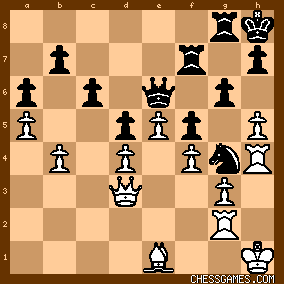
click for larger viewWhite can now seize a dangerous initiative with 59. Rg1! (planning Kg2 and Rh1). But Tchigorin may have counted on Reggio playing the reflexive: 59. hxg6
Now Tchigorin had some counterplay without any facing any immediate risk. 59... Rxg5
60. Kg1
While this move is not objectively bad, it appears that Reggion was just going through the motions and hoping to stay out of trouble and obtain a draw with his famous opponent. But Tchigorin was not ready to let Reggio off the hook quite yet, recognizing that there was now plenty of play in the position. 60... Rh6
Reckoning that he would need to trade off the h4 White Rook to have any real chances of generating threats. 61. RxR QxR

click for larger viewViewed purely objectively, Tchigorin had nothing here. But the g and h files now afforded some scope for the sorts of tactics at which Tchigorin excelled. 62. Qf3 Rg7
Anticipating play on this file.
63. Re2 Rg6
64. Qc3 Qf8
65. Qc5 Kg8
Offering to trade Queens. Should Reggio have accepted the invitation to go into an ending? 
click for larger view66. Kg2
"66. QxQ+ KxQ 67. Kg2 leads to a certain draw." (Tournament Book) Reggio's judgment here--at least as a theoretical matter--was superior to that of the authors of the Tournament Book. The ending after 66. QxQ+, while not a win by any means, certainly favored Black given White's weak g-pawn coupled with the possibility of incursion by Black on the h-file. 66... Qe8
A subtle move that Reggio clearly did not appreciate. 
click for larger view66...Qe8 looks harmless. But beware of such moves when played by a tactical wizard such as Tchigorin. 67. Kf3?
This move should have cost Reggio the game straight off.. With 67. Bf2 or 67. Qa7 (and several other moves), he would have been fine. But now: 67... Re6!
All of a sudden, Tchigorin's Queen has become a monster. 
click for larger view |
|
Feb-23-20
 | | KEG: Post VI
White is quite lost after 67...Re6! But then Tchigorin had an accident: 68. Qb6 Re7?
Black wins after 68...Qh5, e.g., 69. Qd8+ Kf7 70. Re3 (best but insufficient) Qh1+ 71. Ke2 Qg2+ 72. Kd3 NxR 73. KxN Qe4+. Black also wins with 68...c5 69. Qxc5 (69. Qc7 loses after 69...Qh5 70. Qd8+ Kf7 71. Qd7+ Kf8 72. QxR [White is a Rook up but hopelessly lost] Qh1+ 73. Rg2 Qf1+ 74. Rf2 Nh2+ 75. Ke2 76. Ke3 QxB+ 77. Kd3 c4+ 78. Kc2 QxR+) 69...Qh5 70. c8+ Re8 71. Qc2 Qh1+ 72. Rg2 Nh2+ 73. Ke2 QxR+. But now:
69. Kg2 Nf6

click for larger viewTchigorin was now back to having nothing, but not for long. 70. Qc5?
Making things tough for himself. Reggio would have been just fine with 70. Rc2 or 70. Kf1. 70. b5 was another good choice (70...axb5 71. a6! bax6 72. Rc2 Ne4 73.Rxc6 Qh5 74. Qd8+) Now, things were more complicated for Reggio:
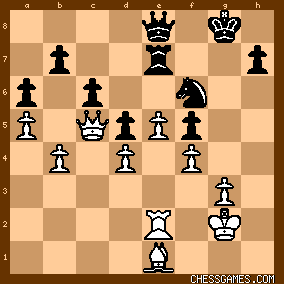
click for larger view70... Ne4
In light of the pin on the e-file, Tchigorin would also have had the edge with 70...Rg7. 71. Qc1
Reggio seems to have been either worn out of just bewildered at this point. With 71. Qb6 or 71. Qc2, he would have had good chances of holding the game. He was still not lost after this lemon, but his task was now harder. 71... Qh5
Even stronger was 71...Rg7
72. Qe3 Rg7!
Making up for lost time. White now faced a tough defense to hang on: 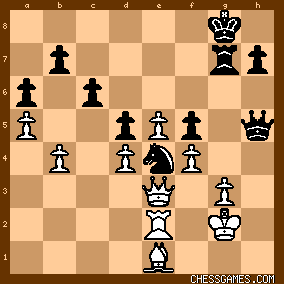
click for larger view73. Qf3 Rg4

click for larger viewReggio would still have been in the game with 74. Rc2 or 74. Rb2 or (my favorite) 74. b5. But here he blundered with: 74. Kf1?
Practically walking into a mating net:

click for larger view74... Rxf4!
"!"--Tournament Book.
Game over!
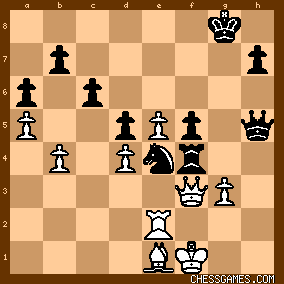
click for larger view75. gxR
75. QxR is impossible in light of 75...Qh1 mate. 75... QxQ+
76. Bf2
Allowing mate in 2, but the game was gone anyway. 76... Ng3+
0-1
Mate next move is unavoidable.
A new finish by Tchigorin. |
|
 |
|
< Earlier Kibitzing · PAGE 2 OF 2 ·
Later Kibitzing> |
|
|
|





